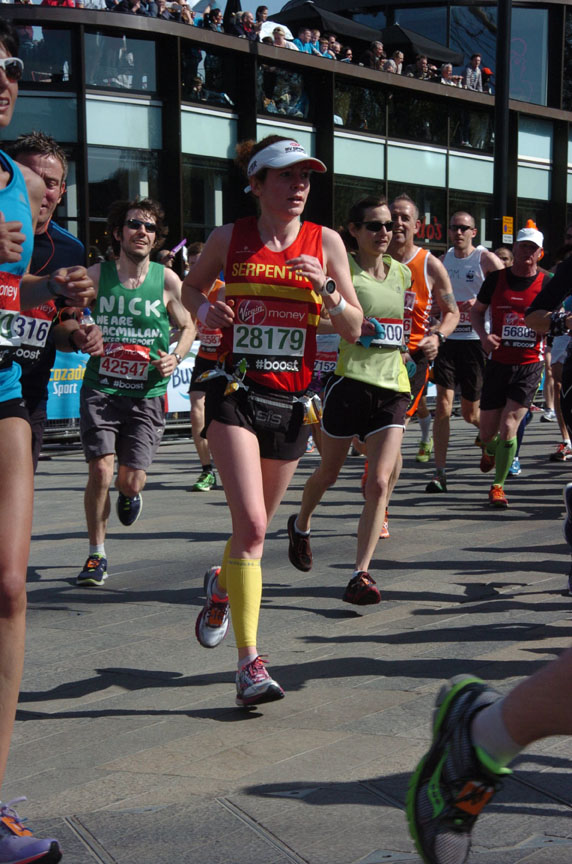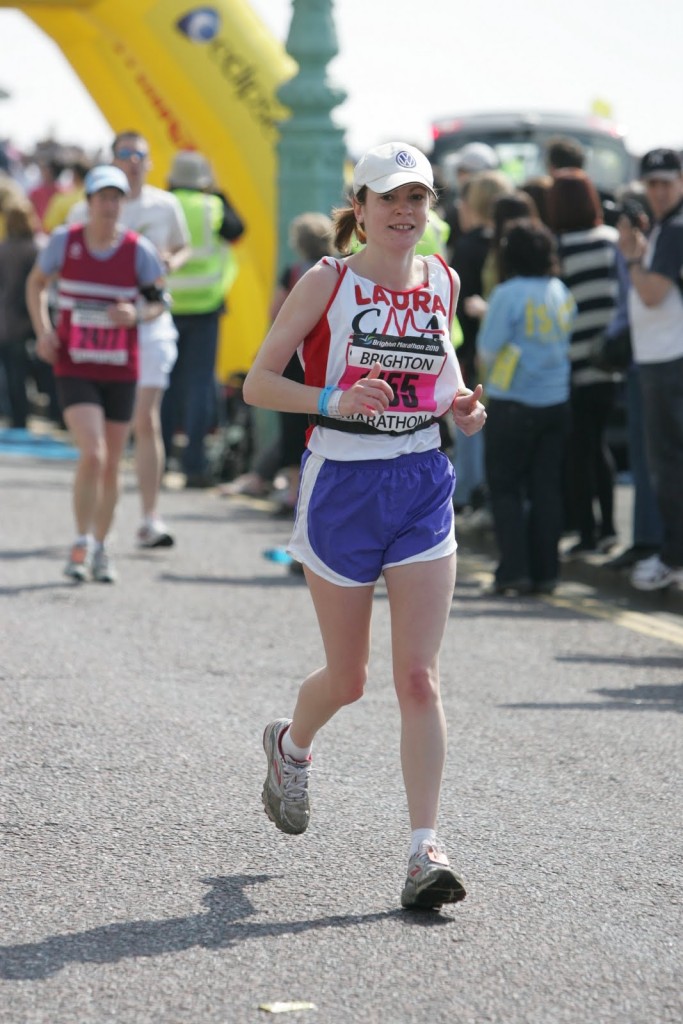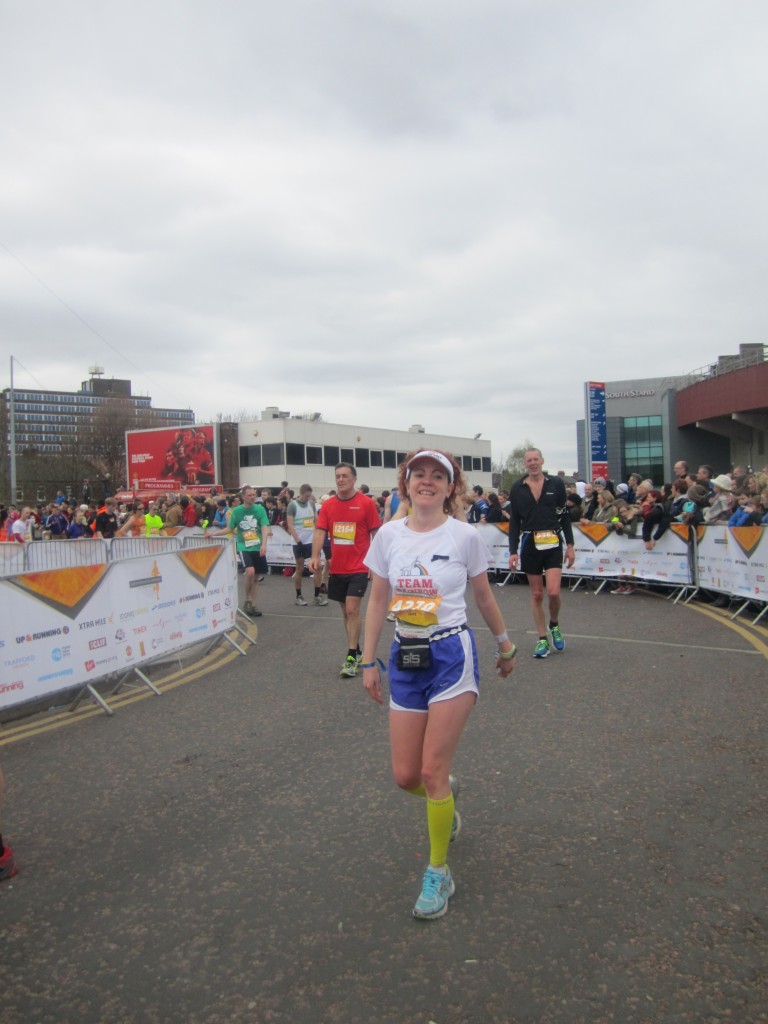This guest post comes from the fantastic Laura Fountain, the brain behind Lazy Girl Running and half of our favourite event of the year, run blogging conference Write This Run. Having run ten marathons, she knows a thing or two about training. When I heard her Marathon Talk interview and found out that she had taken nearly an hour off her marathon time, I asked her to share her tips with you guys.
If you’d like to read more about Laura’s exploits, you should buy her real life, proper paper book, The Lazy Runner and follow her on Twitter.
My marathon PB still stands from Manchester in 2013 where I ran 3:38. This was a 53 minute improvement on my first marathon in Brighton (4:31). Jayne and Bibi asked me to share how it happened. As with most things in running, it’s mainly common sense and patience, but both those things are often easy to leave behind when you put on your running shoes. So it’s probably worth repeating.
1 Consistent training over time
Running didn’t come easy to me. It took six months for me to build up to my first 10k. When I finished it the idea of running another 20 miles seemed preposterous. After I ran Brighton in 2010, I was pretty happy with how it went, but it took another 18 months until I did another marathon.
When I started training for marathon number two in Nottingham, my thoughts turned to running it faster, if for no other reasons, so I could get to the pub sooner. I ran Nottingham, but not as fast as I’d wanted (4:17), then I ran Edinburgh six months later a bit quicker (3:59) and then Manchester in 2013 (3:38). There are three years between my first marathon and my fastest race. That’s three years of (mainly) consistent training. Some people’s upwards trajectory is steeper than others, but there are no short cuts or magic bullets. You have to put in the training, be realistic and have patience.
2 Choice of race
Having said that, there are a few things that can help. Manchester was a nice flat course (they claim to be the flattest in the UK) and that certainly helped. This year I ran Snowdonia marathon – it’s a course where you look at the scenery and not at your watch. Only a fool would try to get a PB on a mountainous route, but it makes the point that some courses are made for going fast and some beg you to slow down. There are things that can go wrong on marathon day that are beyond your control. I ran Venice in 30mph wind, rain and through floodwater. I was hoping for a PB that day. It didn’t happen, so try to enjoy these races as best you can and have a back-up plan.
3 Learn what’s best for you – how your body responds
I teach my own runners now. Some are just starting out and working towards their first 5k, other have progressed with me through a 10k and are now aiming to run a half marathon. I set them sessions and plans, but I also encourage them to learn how to be their own coach. By this I mean knowing how hard to push themselves and when to ease off in a session. To feel confident saying “That’s enough for me” because sometimes we all have off days.
You can take all the best advice from anyone who’ll dish it out but in the end you need to make your own decisions about training because nobody else can feel the signals that your body is giving you. If you need to take two rest days after a hard session – ignore what your plan says and take them. And make your sessions less intense in future. Learn from what you’ve done right and what you’ve got wrong.
4 Club/structured training sessions
This brings me neatly onto the benefits of training with others. I’m a member of Serpentine Running Club where I also help out with the coaching. The lead coaches at the club have bags of experience and are stood out in all weathers sharing this experience with runners on a weekly basis. Structured speed sessions will help you get faster, but only if you do them right. Go to a club session and you’ll find the reps fly by faster when you run with others and you’ll have the benefit of a knowledgeable coach telling you you’re going to slow or too fast to get the benefit of the session.
5 Rest and sleep
The simplest tip of all is the one it’s easiest to forget about. With all the additional miles and speed sessions you’ll be doing, you need to give yourself time to recover. I have a pretty busy week. I work full time, lead running groups two evenings a week and help with coaching at the Serpentine a third. I write a column for Running Fitness magazine and other bits of freelance writing here and there, and I just finished my second book. On top of that I train for marathons and triathlons and see my friends. But most nights I’m in bed by 10.30pm and don’t get up before 6am. Get some sleep and take a day off training once in a while. It will do wonders for more than just the bags under your eyes.
The need for speed
As a footnote to all this, I’d also suggest having a think about what’s realistic for you and why you want to go faster. I’m pretty confident I can run a marathon under 3:30. In fact that was the plan last April but the stars didn’t align that day (notably in getting knocked off my bike a few days before the race) so I’ll have another crack in 2015. I want to get a Boston qualifier, which 3:29 would do, and it would be nice to get a whole hour knocked off that first marathon time. But once I do that, I’m not sure I want to go any faster just for the sake of it, and I know I probably don’t want to put in the additional training it would require.
I ran Snowdonia in the slowest time I’ve done a marathon (4:59) and had a great time the whole way round. So I’d like to do more races like that where it’s not about finishing as fast as you can. We often have a drive to get faster without necessarily thinking about where it comes from. If it’s because everyone else is getting faster or because you think you should, these reasons won’t help you get out of bed in the morning or do the second workout of the day. Getting to the pub a bit quicker, however…



great read from a great runner, well done.
Great post really handy tips. I would also add (from bitter experience!) if you have done all this training and got in to your best form – get the start right! By this I mean plan your route to the start to get there in good time, especially if it’s a larger city marathon. Then you will have time to drop your stuff off and queue for the loo etc. You don’t want to be in sub 4hr form and find yourself starting behind a wall of knitted rhinos and other crazy costumes.
Haha, nightmare! We had a similar experience at Blenheim Palace Half Marathon. There were two shorter races – including a kids’ fun run – scheduled to start after the half. We got stuck in *that* traffic and were half an hour late for the start of our race. This meant little kids on their fun run were overtaking us on the home straight. The ignominy… :/
Hi there, I’m loving this whole site and this article seems really helpful so thanks : ) I’ve been running for a year or so just to aid improved general fitness but I’ve now signed up for a marathon now and so my weekly runs are getting longer. I’m struggling with energy levels even though I’m sure my eating/sleeping habits are ok…..I was wondering, would you recommend using one of those energy gels that are on the market and if so, any particular one? Cheers, Ruth x
Hi Ruth,
– I found during my first marathon I needed *at least* an extra hour of sleep a night, even on the days I didn’t have a long run. I would end up falling asleep on the sofa and going to bed at 9pm! So, I have to say some tiredness is quite normal as far as marathon training goes. Maybe take a multivitamin with B vitamins in just to give you an extra boost.
I like to use energy gels only for runs over an hour. Our bodies can’t hold enough fast-burning energy for longer runs, so need additional carbs. My favourite are Clif Shot Bloks, while Mum prefers High 5 gels.
If you’re doing long runs without them, you might be switching into using energy straight from fat, which is very hard on the body. Hopefully if you start using gels, that might fade.
Best of luck,
Bibi
Hey thanks very much for your comments Bibi, much appreciated. Just one other thing if it’s not too cheeky, any tips on how to prevent a toenail from falling off? Or should I just except the loss and feel proud I’m training hard enough to start loosing parts of my body : ) ??
Cheers
Ruth x
haha, you hit the nail on the head (Sorry) – just roll with it! Make sure it’s not because your shoes are too small (rule of thumb is half a size bigger than you would buy normally), but it’s just a general fact of marathon training for me. I had 7 toenails by the end of training last time.
And think about what a rockstar you are!